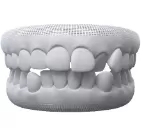Braces are an effective way to straighten teeth and improve your smile, but they require extra care to maintain good oral hygiene. Food particles and plaque can easily get trapped in brackets and wires, increasing the risk of cavities and gum disease. Proper cleaning techniques are essential to keep your teeth and gums healthy throughout your orthodontic treatment.
Maintaining good oral hygiene with braces may seem challenging, but with the right tools and techniques, it becomes a simple part of your daily routine. Brushing, flossing, and avoiding certain foods can help protect your teeth from staining and decay. Following your orthodontist’s advice and adopting good cleaning habits will ensure the best results once your braces are removed.
Brushing Techniques for Braces
Brushing your teeth with braces requires extra attention to ensure that all food particles and plaque are removed. Using a soft-bristled toothbrush or an electric toothbrush can help clean around brackets and wires effectively. Holding the brush at a 45-degree angle and using small circular motions helps reach areas that are difficult to clean with regular brushing.
It is recommended to brush at least twice a day, but ideally after every meal, to prevent plaque buildup and staining. Special orthodontic toothbrushes are available to make cleaning around braces easier. Using fluoride toothpaste strengthens the enamel and reduces the risk of cavities, keeping your teeth healthy throughout your orthodontic treatment.
Flossing with Braces: Why It’s Important
Flossing with braces can be tricky, but it is essential for removing food debris and plaque between teeth. Traditional floss may not be effective because the wires make it difficult to reach certain areas. Orthodontic flossers, floss threaders, or water flossers can make the process easier and more effective.
Flossing should be done at least once a day to prevent gum inflammation and cavities between the teeth. A floss threader helps guide the floss under the archwire, allowing for proper cleaning without damaging the braces. Water flossers use a stream of water to flush out debris and bacteria, making them a convenient alternative to traditional flossing.
Using Mouthwash for Added Protection
Mouthwash is a useful addition to your oral hygiene routine, especially when wearing braces. It helps kill bacteria, freshen breath, and reach areas that brushing and flossing might miss. An alcohol-free, fluoride mouthwash can strengthen the enamel and protect against cavities while soothing any gum irritation caused by braces.
Rinsing with mouthwash after brushing and flossing can remove leftover debris and reduce the risk of gum inflammation. It is important to swish the mouthwash around for at least 30 seconds to allow the active ingredients to work effectively. Using mouthwash daily provides an extra layer of protection for your teeth and gums during orthodontic treatment.
Foods to Avoid While Wearing Braces
Certain foods can damage braces or make cleaning more difficult, so it is important to be mindful of what you eat. Hard foods such as nuts, popcorn, and hard candies can break brackets or bend wires, leading to discomfort and additional orthodontic visits. Sticky foods like caramel and chewing gum can get stuck in the braces, making them difficult to clean.
Crunchy foods like raw carrots and apples should be cut into small pieces to prevent unnecessary pressure on the braces. Sugary foods and drinks should be consumed in moderation, as they increase the risk of plaque buildup and tooth decay. Choosing soft, braces-friendly foods can help protect your orthodontic appliances and make cleaning easier.
Dealing with Braces Discomfort and Irritation
Braces may cause mild discomfort or irritation, especially after adjustments. Using orthodontic wax can help reduce irritation caused by brackets rubbing against the inner cheeks or lips. Applying a small amount of wax over any sharp edges can prevent soreness and make wearing braces more comfortable.
If you experience soreness after an adjustment, rinsing with warm salt water can help soothe the gums and reduce inflammation. Over-the-counter pain relievers can also be taken if necessary, following your orthodontist’s recommendations. Staying patient and allowing your mouth to adjust to the braces will help minimize discomfort over time.
How to Clean Braces While Traveling
Maintaining oral hygiene while traveling is essential, even when access to a bathroom is limited. Carrying a travel-sized toothbrush, toothpaste, and floss makes it easier to clean your braces on the go. Disposable orthodontic brushes or interdental brushes can help remove food particles from braces when brushing is not immediately possible.
Drinking water after meals can help rinse away food debris and bacteria, reducing the risk of plaque buildup. Chewing sugar-free gum for a few minutes can also stimulate saliva production, which naturally cleanses the mouth. Staying prepared with a braces-friendly hygiene kit ensures that your teeth remain clean no matter where you go.
The Importance of Regular Orthodontic Checkups
Routine visits to your orthodontist are crucial for monitoring the progress of your treatment and making necessary adjustments. Your orthodontist will check for any loose brackets, bent wires, or signs of gum disease, ensuring that your braces remain effective. Skipping appointments can delay progress and lead to complications that could have been prevented with early intervention.
During checkups, your orthodontist may also recommend professional cleanings to remove plaque and tartar from hard-to-reach areas. These cleanings help prevent cavities and gum problems that can develop if braces are not properly maintained. Keeping up with scheduled orthodontic visits will ensure that your treatment stays on track and your oral health remains in good condition.
Retaining Your Smile After Braces
Once your braces are removed, it is essential to wear a retainer as prescribed by your orthodontist to maintain the results. Teeth can shift back into their original position if retainers are not worn consistently. Cleaning retainers properly is just as important as maintaining braces, as bacteria and plaque can accumulate on them over time.
Retainers should be cleaned daily with a soft brush and mild soap to prevent buildup and odors. Avoid using hot water, as it can warp the retainer and affect its fit. Following your orthodontist’s instructions on wearing and caring for your retainer will help keep your newly aligned teeth in place for years to come.
Why Proper Braces Care Is Essential
Taking care of your braces is not just about maintaining a beautiful smile but also about protecting your overall oral health. Poor hygiene can lead to cavities, gum disease, and staining that may remain even after the braces are removed. A consistent cleaning routine ensures that your teeth remain strong and healthy throughout your orthodontic journey.
Being mindful of what you eat, using the right oral hygiene tools, and visiting your orthodontist regularly are key to successful treatment. Developing good habits now will not only help during treatment but will also set the foundation for a lifetime of healthy teeth. Prioritizing braces care will result in a confident smile once your treatment is complete.
Schedule Your Orthodontic Consultation at Mint Dental Care
If you have braces or are considering orthodontic treatment, Mint Dental Care in Dubai provides expert care and personalized guidance to help you maintain excellent oral health. Our experienced orthodontists offer professional cleanings, adjustments, and hygiene tips to ensure a smooth and successful treatment process.
Maintaining your braces properly will lead to better results and a healthier smile in the long run. Whether you need advice on cleaning techniques or an adjustment appointment, our team is here to help. Call us today to schedule your consultation and take the next step toward a perfectly aligned smile.















